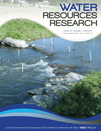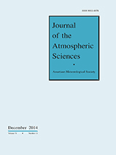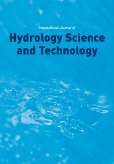
Russian Meteorology and Hydrology
Scope & Guideline
Exploring the depths of meteorology and hydrology.
Introduction
Aims and Scopes
- Atmospheric Processes and Climate Change:
Research on large-scale atmospheric circulation patterns, their variations, and impacts on climate change, particularly within the Russian context. - Hydrological Studies and Water Resources Management:
Focus on hydrological modeling, streamflow forecasting, and the assessment of water resources, including impacts from climate change and anthropogenic activities. - Meteorological Observations and Remote Sensing:
Utilization of remote sensing technologies and observational data to monitor atmospheric conditions, weather events, and environmental changes. - Environmental Impact Assessments:
Studies evaluating the effects of meteorological and hydrological changes on ecosystems, agriculture, and public health. - Application of Advanced Modeling Techniques:
Development and application of numerical models, including machine learning and neural networks, for predicting meteorological phenomena and analyzing climate data.
Trending and Emerging
- Machine Learning and AI in Meteorology:
There is a growing trend in applying machine learning and artificial intelligence techniques for predicting weather patterns and analyzing atmospheric data, indicating a shift towards data-driven methodologies. - Climate Change Adaptation Strategies:
Research emphasizing the impacts of climate change on various sectors, particularly agriculture and public health, along with strategies for adaptation, is gaining prominence. - Hydrological Extremes and Their Management:
An increasing focus on the analysis of extreme weather events, such as floods and droughts, and their management reflects a response to the rising frequency of such occurrences. - Satellite Remote Sensing Applications:
The use of satellite data for monitoring environmental changes and hydrological dynamics is becoming more prevalent, showcasing advancements in remote sensing technology. - Interdisciplinary Environmental Research:
Emerging themes highlight the intersection of meteorology with public health, ecology, and urban planning, indicating a trend towards holistic studies that consider multiple factors affecting environmental conditions.
Declining or Waning
- Traditional Meteorological Techniques:
There has been a noticeable decrease in studies relying solely on traditional meteorological methods without integration of modern technology or data analysis techniques. - Localized Climate Studies Without Broader Context:
Research focusing narrowly on specific localities without connecting findings to broader climatic trends or regional impacts seems to be diminishing. - Static Environmental Assessments:
Papers that assess environmental impacts without dynamic modeling or consideration of changing conditions are less prevalent, as the field moves towards more integrated and adaptive approaches.
Similar Journals

WATER RESOURCES RESEARCH
Empowering Knowledge in Water Resource ScienceWATER RESOURCES RESEARCH, published by the American Geophysical Union, stands as a premier journal in the field of environmental science, specifically within the domain of water science and technology. With an impressive impact factor and a categorical ranking of Q1 for 2023, it ranks within the top 10% of relevant journals, evidencing its critical role in advancing the knowledge and application of water resources research. Since its inception in 1965, the journal has been dedicated to rigorous research that addresses pressing global challenges related to water resource management, hydrology, and environmental sustainability. The journal's comprehensive publication scope aims to present innovative findings and methodologies that can shape effective policies and practices. Although it does not offer open access, the robust research it publishes continues to influence academics and practitioners alike, ensuring its position as an essential resource for anyone engaged in the pursuit of water-related knowledge and solutions.

Hydrology Research
Connecting researchers for impactful hydrology discoveries.Hydrology Research, a leading academic journal published by IWA Publishing, is dedicated to advancing the field of water science and technology. With an impressive impact factor and a Q2 ranking in its category, the journal plays a pivotal role in disseminating innovative research and practices in hydrology. Established in 1973 and transitioning to an Open Access model in 2020, it provides unrestricted access to high-quality articles that cover a broad spectrum of topics, including hydrological processes, water management, and environmental impact assessments. Situated in Denmark, Hydrology Research continues to thrive as an essential platform for researchers, professionals, and students alike, encouraging the exchange of ideas that contribute to sustainable water solutions worldwide. With a comprehensive coverage of research converging from 1973 to 2024, it stands as a testament to ongoing progress in the water science community.

Journal of Hydrology
Innovating Solutions for Global Water ChallengesThe Journal of Hydrology, published by ELSEVIER, stands as a premier outlet for scholarly research in the field of water science and technology. With an impactful history dating back to 1949 and a convergence period extending to 2024, this journal has consistently provided a platform for cutting-edge research that shapes our understanding of hydrological processes and their implications. Located in the Netherlands, its commitment to excellence is underscored by its impressive Scopus rank of 15 out of 261 in the Environmental Science category, placing it in the 94th percentile overall, and achieving a prestigious Q1 category allocation for 2023. While the journal does not currently offer open access options, it remains an invaluable resource for researchers, professionals, and students seeking to deepen their expertise in hydrology. The rigorous peer-review process ensures the publication of high-quality manuscripts that contribute significantly to the advancement of knowledge in this critical domain.

Idojaras
Exploring the intricacies of climate and weather phenomena.Idojaras, a prominent journal published by the Hungarian Meteorological Service, has been a vital contributor to the field of Atmospheric Science since its inception in 1980. With a specific focus on the intricacies of weather phenomena, climate variability, and environmental change, this journal serves as a platform for researchers and professionals to disseminate their findings. Although currently categorized in Q4 of Atmospheric Science with a Scopus rank of #122 out of 148, Idojaras is dedicated to improving its impact and visibility through rigorous peer-reviewed research and comprehensive analyses that engage a global audience. This scholarly publication, which operates without open access, is pivotal for advancing knowledge in meteorological studies, thereby appealing not only to seasoned scientists but also to students and scholars eager to explore this dynamic field. Located in Budapest, Hungary, the journal continues to strive for excellence in its coverage through the convergence of past and present meteorological research, making it a significant resource for anyone interested in the atmospheric sciences.

JOURNAL OF THE AMERICAN WATER RESOURCES ASSOCIATION
Exploring the depths of water science for a sustainable tomorrow.The JOURNAL OF THE AMERICAN WATER RESOURCES ASSOCIATION, published by Wiley, is a premier platform dedicated to advancing the field of water resource management and research. With an ISSN of 1093-474X and an impressive Q1 ranking in multiple categories, including Earth-Surface Processes, Ecology, and Water Science and Technology, this journal serves as a vital resource for professionals, researchers, and students alike. Established in 1967 and set to converge through 2024, it has consistently published cutting-edge research that influences policy and practice in water resource management. The journal's open access option enhances its reach, ensuring that critical findings are accessible to a wider audience. The Scopus rankings further underscore its impact, placing it in the top quartile within its fields, highlighting its importance in shaping scholarly discourse. As a significant contributor to the understanding and management of freshwater systems, the journal offers a crucial means for sharing insights and fostering collaboration in the vital realm of water resources.

JOURNAL OF THE ATMOSPHERIC SCIENCES
Exploring the Complexities of Our AtmosphereJOURNAL OF THE ATMOSPHERIC SCIENCES, published by the American Meteorological Society, stands as a premier resource for the latest research in atmospheric sciences. With an impressive impact factor and a Q1 ranking in the Atmospheric Science category for 2023, this journal is recognized for its rigorous peer-reviewed articles that contribute to the understanding and advancement of weather, climate, and dynamics of the atmosphere. Established in 1969, the journal has maintained high academic standards and delivers valuable insights spanning over five decades, thus catering to an audience of researchers, professionals, and students alike. Although it does not offer open-access options, it provides critical access through various institutional subscriptions, ensuring that significant research findings are disseminated widely within the scientific community. The journal's address is located at 45 Beacon St, Boston, MA 02108-3693, United States, and it accepts submissions and articles until 2024, continuing its legacy of excellence in atmospheric research.

ATMOSPHERE-OCEAN
Illuminating the Dynamics of Our Planet's SystemsATMOSPHERE-OCEAN is a premier peer-reviewed journal published by Taylor & Francis Ltd, dedicated to advancing the fields of atmospheric science and oceanography. Since its inception in 1963, this journal has served as a crucial platform for researchers, professionals, and students, facilitating the dissemination of significant findings and innovative methodologies in understanding the complex interactions between the atmosphere and the ocean. With its journal ranking in the Q3 category for Atmospheric Science and Q2 for Oceanography as of 2023, along with its Scopus rankings, ATMOSPHERE-OCEAN maintains its relevance by addressing current topics such as climate change, hydrology, and ocean circulation patterns. For those seeking to contribute to or stay informed about the latest research in these critical fields, ATMOSPHERE-OCEAN is an invaluable resource that combines rigorous scholarship with practical implications for environmental management and policy.

Journal of Water and Climate Change
Uniting Research and Policy for Water and Climate SolutionsJournal of Water and Climate Change is a premier open-access journal published by IWA Publishing, dedicated to advancing the understanding of the interplay between water resources and climate change. With an ISSN of 2040-2244 and an E-ISSN of 2408-9354, this journal has established itself as a crucial platform for interdisciplinary research, publishing high-quality articles that address the challenges posed by climate variability on water systems globally. Since achieving open access status in 2021, the journal has fostered wider dissemination of knowledge among its audience, featuring works that span pivotal topics in Atmospheric Science, Global and Planetary Change, and Water Management. Notably ranked within the top quartiles in several relevant categories as of 2023, it occupies a vital position in the academic community, offering insights that are essential for policymakers, environmental scientists, and researchers striving to create sustainable solutions for water and climate challenges. Its commitment to excellence is reflected in its strong Scopus rankings, standing at the 66th percentile in Water Science and Technology and 65th percentile in Management, Monitoring, Policy, and Law. Located in the United Kingdom, this journal not only serves as a repository of cutting-edge research from 2010 to 2024 but also engages a diverse readership passionate about promoting sustainable water management practices.

International Journal of Hydrology Science and Technology
Driving Sustainable Practices in Water Resource ManagementThe International Journal of Hydrology Science and Technology, published by InderScience Enterprises Ltd, is a distinguished platform dedicated to advancing knowledge in the field of hydrology, environmental engineering, and water science. With an ISSN of 2042-7808 and an E-ISSN of 2042-7816, this journal, established in 2011 and continuing through 2024, serves as an essential resource for researchers, professionals, and students alike. Despite being categorized in the Q3 quartile across multiple disciplines including Earth and Planetary Sciences, Environmental Engineering, Waste Management and Disposal, and Water Science and Technology, the journal maintains a reputation for contributing significant findings that impact both theory and practical applications in addressing hydrological challenges. Currently unavailable through Open Access options, the journal remains committed to disseminating valuable research that informs sustainable practices in water resource management. The editorial team encourages submissions that explore innovative strategies and methodologies while fostering interdisciplinary discussions, making this journal a pivotal player in shaping the future of hydrological science.

Tethys-Journal of Mediterranean Meteorology & Climatology
Enhancing Understanding of Regional Climate ChallengesTethys - Journal of Mediterranean Meteorology & Climatology, published by the Associació Catalana de Meteorologia (ACAM), serves as a specialized platform dedicated to advancing the study of meteorological and climatological phenomena within the Mediterranean region. With a Scopus Rank of #94 out of 148 in the field of Atmospheric Science, this journal is positioned in the Q4 category, reflecting a growing recognition among researchers focused on regional climate variations and environmental challenges. Established in 2012 and publishing through 2023, Tethys aims to provide open access to high-quality research articles that address critical issues impacting climate and weather patterns, thus contributing to a deeper understanding of Mediterranean meteorology. The journal’s mission aligns closely with the increasing global emphasis on climate studies and serves as an essential resource for academics, practitioners, and students dedicated to sustainably addressing the environmental and climatic challenges faced by this diverse and dynamic region.